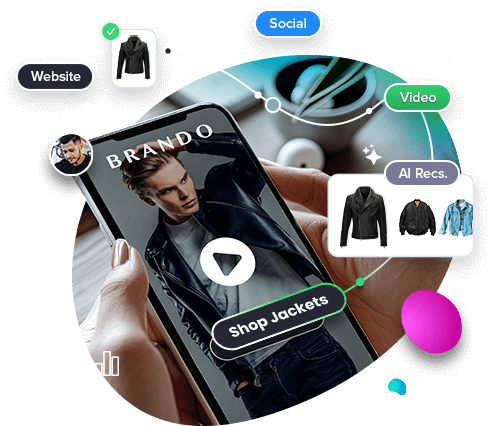Innervate for Dynamic Email Content
Supporting Connection and Conversion Through Engaging Email Marketing


Email marketing remains one of the most effective tools for customer engagement and revenue generation. It’s also cost-effective and ROI-friendly—boasting an average of $36 for every $1 spent.
Here’s the thing: Traditional, static email strategies aren’t enough to meet the expectations of modern consumers or hit KPI targets as the world around us changes. Responsive, personalized email solutions enable businesses to break through the noise of crowded inboxes—and deliver impactful messaging that drives intended actions. An investment in dynamic email marketing can help your organization transform its email strategy to achieve better engagement, improved efficiency, and higher ROI.
Key Strategies for Optimizing Email Campaigns
Your toolkit of strategies for better email campaigns should specifically address the most common challenges you face.
For example, dynamic email marketing comes with a heady set of hurdles, from managing complex workflows to ensuring compliance with evolving regulations to navigating siloed content creation processes.
Dynamic solutions resolve these pain points by offering streamlined workflows, automated compliance checks, and accessible analytics that pave a neat pathway for actionable insights.
If that’s where you want to end up, we would suggest starting by:

1. Activating dynamic content for personalized email experiences.
Unless you plan on writing endless emails individually, personalization requires dynamic content.Static templates and generic messaging fall short of engaging audiences. (Opting for that content strategy will also burn out your team.)
Here’s how to leverage dynamic content:
Deliver context-driven messaging.
Emails can now be as unique as their recipients! Which would you rather open: A bland one-size-fits-all missive or a tailored message that speaks directly to your preferences and behavior?
With dynamic content, you can automatically adjust email elements based on customer behaviors, preferences, and segmentation to turn stale templates into sparkling, adaptive, and immensely engaging stories.
Automate personalization at scale.
Use AI to segment audiences and draft relevant content. This reduces reliance on manual processes while freeing marketing teams to focus on high-impact strategies.

2. Enhancing email efficiency with advanced automation.
Due to manual processes, many email teams face inefficiencies with content updates, scheduling, and other tasks. Advanced automation removes these roadblocks, enabling teams to work smarter, not harder.
Here’s how automation can streamline your email strategy:
Reduce manual workload with business process automation (BPA) tools.
Implement BPA to manage repetitive tasks such as segmentation, content updates, and scheduling.
Example: Automate the creation and delivery of time-sensitive campaigns, such as holiday promotions, to ensure timely execution without added workload—and to gift your teams the ability to iterate and experiment during high-volume seasons without the added stress.
Ensure email deliverability and compliance.
Use automation to implement compliance checks that ensure email campaigns meet regulatory requirements (e.g., GDPR, CCPA).

3. Using AI to optimize customer journeys in email.
AI enables marketers to deliver hyper-personalized, data-driven email experiences. This empowers businesses to elevate the way they connect with customers. Today, with intelligent tools at hand, email marketers can take steps to know every email they send will resonate with recipients.
This is true right down to the modular elements of each email. Brands can implement dynamic elements such as countdown timers, live product recommendations, or location-specific promotions to deliver hyper-relevant content. AI-powered loyalty banners, for example, can reflect real-time rewards or member-specific offers, increasing click-through rates and customer satisfaction.
However, AI isn’t just for personalization and relevance without the busywork. You can use it to help glean analytics (and resultant insights) faster, so you can make better decisions in near-real time.
Here’s how to integrate AI into your email strategy:
Achieve hyper-personalization with AI.
Use AI to analyze customer behavior, preferences, and engagement patterns to tailor content for individual recipients.
Example: Dynamically adjust content at the time of email open to reflect the most relevant products, offers, or messages.
Gain deep customer insights through AI-driven analytics.
With real-time data analysis, your team can see not only what works but also why—ensuring every email performs better than the last.
Fortunately, achieving that goal can be relatively low-lift. First, implement AI tools to analyze campaign performance and customer interactions, uncovering actionable insights. Then, refine your email strategy by understanding what content, timing, and messaging resonate most with your audience.


4. Fostering a cohesive email strategy aligned with other channels.
Consistency across channels is key to delivering seamless customer experiences. When email campaigns align with your broader marketing strategy, customers enjoy a unified journey that builds trust and drives engagement.
Here’s how to integrate email into your omnichannel strategy:
Develop an omnichannel approach to email marketing.
Sync email campaigns with other touchpoints, such as your website, social channels, and customer relationship management (CRM) systems. For example, you could coordinate email content with website promotions or social media ads for a cohesive narrative.
Humanize automated email interactions.
Use AI to automate routine responses while reserving high-value interactions for human agents.
Pro tip: Proactive, personalized emails show your readers you’re paying attention. Leverage dynamic content to add bespoke touches, such as location-based recommendations or loyalty updates, to automated emails.

Practical Steps to Get Started with Dynamic Email Marketing
Ready to transform your email strategy?
Here’s where to begin:
- Audit your current email performance. Identify gaps where dynamic content, AI, or automation could enhance engagement or efficiency.
- Focus on high-impact opportunities. Start with the most visible or conversion-driven campaigns to maximize ROI from the outset.
- Implement changes incrementally. Begin with small-scale dynamic content updates or AI segmentation before expanding to more advanced use cases.
Elevate Your Email Marketing with Dynamic Solutions
Email marketing is a powerful channel that deserves a dynamic approach. By leveraging real-time data, AI-driven personalization, and advanced automation, you can transform your email campaigns from static to strategic.
The result? Higher engagement, seamless customer journeys, and measurable ROI.
Speak to an Innervate team member today to discover how we can help you elevate your email marketing strategy.